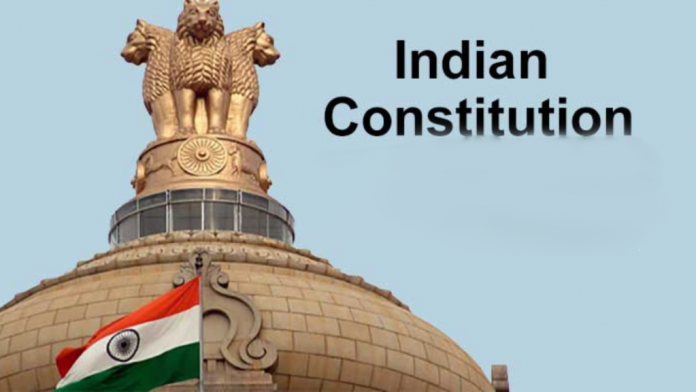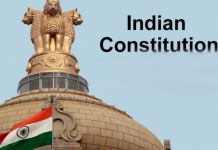This article is written by Astuti Dwivedi of Hidayatullah National Law University. It discusses about the 8th Schedule of the Indian Constitution and gives a proper analysis of its framing in the past and its importance in today’s time.
Table of Contents
Introduction
The Indian Constitution is known to be the longest written Constitution in the world. Commenced in the year 1950, it is divided into 12 Schedules, 25 Parts and 448 Articles. So far, there have been 104 Amendments to the Constitution. The variety and diversity of India are well known and accepted in a number of festivals, cultures and traditions. The most significant feature, however, is the various languages that are spoken in this nation as India is home to 121 languages and 270 mother tongues. Of these multiple languages, 22 languages are signified as official languages under the 8th Schedule of the Constitution. This article attempts to highlight the historical making, purpose and functioning related to this Schedule.
History of 8th Schedule of the Indian Constitution
The Indo-Aryan and Dravidian language families include the majority of the components that make up the Indian language. The former belongs to the Indo-European language family and is spoken by 70% of Indians, predominantly in North India, whereas Dravidian languages are spoken by just 22% of the population and are prevalent in the South. Other Indian languages belong to the Austro-Asian or Sino-Tibetan (within that, Tibeto-Burman) linguistic groups, and there are a few isolated languages, for example, the Nihali or Kalto- the language of Maharashtra state.
English and Hindi together make up an essential part of the administrative dealings of the country. However, this prospect does not impose any burden on anyone to speak the major languages. The Schedule offers an open ambit and today stands with 22 languages allowing the people their freedom to choose whichever language they wish to speak. States have the freedom to select and make any of their regional languages crucial for their governmental issues and education. However, the history of this Schedule is marked by many significant timeline issues.
Racing back to the freedom movement, we see that the Britishers made English their language for communication and Indians chose Hindi majorly to communicate. With the finalisation of the Constitution in the year 1950 came the addition of the Eighth Schedule, which marked 14 languages under ‘official languages’ status. It declared Hindi as the official Indian Language.
At first, came the Official Languages Act of 1963 which was based on making both Hindi and English the language of the Parliament. In the later year, 1964, a proposal was made to end the use of English. But this resulted in protests all over the country in states like Andhra Pradesh, Karnataka, Kerala, Pondicherry, Tamil Nadu and West Bengal. This led to the fallout of the proposal. Further, in the year 1965, an Anti-Hindi Agitation had started It stood against Hindi as an official language of India. This agitation, too, had to be quashed down. In the year 1967 came the Official Languages Resolution which made English open and free to be used.
Thereafter more languages were added to the Schedule through the Amendment Acts of 2002 and 2004, namely, the 71st Amendment and the 92nd Amendment respectively.
Official Languages Act, 1963
In 1963 came the Official Languages Act which was passed by the Federal Parliament. It legally-established Hindi and English as the languages used in the Parliament while allowing the states and union territories to choose their own official languages freely.
Section 3 of this Act cancels the 15 year expiration period that was set for the use of English. It permits usage of both English and Hindi Resolutions, general instructions, rules, announcements, administrative or other reports, or press releases issued or issued by the central government or a ministry, department, office, or organisation owned or controlled by the central government contracts, agreements, licences, permits, notices, and tender forms issued by the federal government or any ministry, department, office, or state corporation are all subject to the same rules.
The provisions on the use of English will remain in effect until resolutions for the discontinuance of the use of the English language for the purposes mentioned in the Act have been passed by the legislatures of all States that have not adopted Hindi as their official language, according to Section 5 of the Act. Both Houses of the Federal Parliament must also enact a resolution to this effect.
The Governor of a State (with the exception of Jammu and Kashmir) may authorise the use of Hindi or the official language of the State in addition to English for the purposes of any judgement, decree, or order passed or made by the High Court for that State and for any judgement, decree, or order passed or made by in that language under Section 7 of the Official Languages Act (other than English).
This Act was further amended in 1976 to establish the Official Languages Rules, which were again amended in 1987.
Official Language Resolution, 1968
Passed by both the houses of the Parliament on January 18, 1968, the Official Language Resolution was brought in order to increase the usage of the Hindi language for official purposes by the Union of India.
The Resolution states Hindi to be the official language of the Union under Article 343 of the Constitution. Under Article 351, the Union will, as its duty, promote the spread of the Hindi language and work for its development so as to help it serve as a medium of expression for all elements of the composite culture of India. Article 343 (2) provided that English shall be continued to be used in the official works of the Union for a period of 15 years from the date of commencement of the Constitution, i.e., 25th January 1965. With the passing of this resolution, Article 343(3) came to the provisions that made the continuation of English valid even after 25th January 1965. It gave the parliament the power to make laws in this regard.
The resolution also made the knowledge of either English or Hindi compulsory for the selection of candidates for the various posts in the central government.
The final resolution by the Houses reads as,
“This House resolves –
- that compulsory knowledge of either Hindi or English shall be required at the stage of selection of candidates for recruitment to the Union services or posts except in respect of any special services or posts for which a high standard of knowledge of English alone or Hindi alone, or both, as the case may be, is considered essential for the satisfactory performance of the duties of any such service or post; and
- that all the languages included in the Eighth Schedule to the Constitution and English shall be permitted as alternative media for the All India and higher Central Services examinations after ascertaining the views of the Union Public Service Commission on the future scheme of the examinations, the procedural aspects and the timing.”
Purpose of 8th Schedule of the Indian Constitution
The purpose of the Eighth schedule is simply to bind together the diversity of the Indian subcontinent. Listing one language as a national language might turn into an unjustified stand for the rest of the languages spoken in India. Thus terming them as official gives a safe headline to progress and embrace diversity. It can thus be listed that the schedule is marked with purpose as:
- Providing safe ambit to the languages and diversity in the nation.
- Give equal representation to the multi-racial, multi ethical nation.
- Empower indigenous groups by giving them access to government in their native language.
- Enables more possibility to do business, trade and commerce in a more efficient manner via common language grounds.
Constitutional provisions related to 8th Schedule of the Indian Constitution
The official languages of India are included in Part XVII of the Indian Constitution. The Articles included are from Articles 343 to 351. The constitutional provisions related to the Eighth schedule are articulated in Articles 344, Article 344 (1) and Article 351 of the Constitution.
Article 344 provides for the constitution of a commission by the President on the expiration of five years. Article 351 provides for the spread of the Hindi language to develop it. It was to serve as a medium of expression for all the elements of the composite culture of India.
Article 29 of the Indian Constitution around this context says that a section of citizens having a distinct language, script or culture are vested with the right to conserve the distinct language. In this regard, both the citizens and the state have equal responsibility to conserve the distinct language.
List of languages in 8th Schedule of the Indian Constitution
The Schedule comprises of twenty-two official languages. Of these 22, 14 languages were included initially in the Constitution. Sindhi was added in the year 1967 by the Twenty-first Amendment of the Constitution of India. Thereafter, three more languages, Konkani, Manipur and Nepali were included by the Seventy- First Amendment Act of the Constitution. The further entries of Bodo, Dogri, Maithili and Santhali were added by the Ninety-Second Amendment Act of the Constitution thus making the count 22 as a whole. The 22 languages which are included in the Schedule are as follows:
| (1) Assamese, (2) Bengali, (3) Gujarati, (4) Hindi, (5) Kannada, (6) Kashmiri, (7) Konkani, (8) Malayalam, (9) Manipuri, (10) Marathi, (11) Nepali, | (12) Oriya, (13) Punjabi, (14) Sanskrit, (15) Sindhi, (16) Tamil, (17) Telugu, (18) Urdu (19) Bodo, (20) Santhali, (21) Maithili and (22) Dogri. |
The list doesn’t end here. Considering the extent of diversity prevailing in the society, and the number of languages in mother tongues existent, more and more languages are proposed to be added to this Schedule. There are approximately 38 languages that have been raised with a demand to be included in the Schedule.
These are: (1) Angika, (2) Banjara, (3) Bazika, (4) Bhojpuri, (5) Bhoti, (6) Bhotia, (7) Bundelkhandi (8) Chhattisgarhi, (9) Dhatki, (10) English, (11) Garhwali (Pahari), (12) Gondi, (13) Gujjar/Gujjari (14) Ho, (15) Kachachhi, (16) Kamtapuri, (17) Karbi, (18) Khasi, (19) Kodava (Coorg), (20) Kok Barak, (21) Kumaoni (Pahari), (22) Kurak, (23) Kurmali, (24) Lepcha, (25) Limbu, (26) Mizo (Lushai), (27) Magahi, (28) Mundari, (29) Nagpuri, (30) Nicobarese, (31) Pahari (Himachali), (32) Pali, (33) Rajasthani, (34) Sambalpuri/Kosali, (35) Shaurseni (Prakrit), (36) Siraiki, (37) Tenyidi and (38) Tulu
Classical languages under 8th Schedule of the Indian Constitution
In the present day scenario, there are six languages that are held under the ‘classical’ status in India; namely, Tamil (2004), Sanskrit (2005), Kannada (2008), Telugu (2008), Malayalam (2013) and Odia (2014). All these six languages are listed under the Eighth Schedule of the Constitution.
The Ministry of Culture lists the terms which qualify a language as a classical language.
- High antiquity of its early texts or recorded history over a period of 1500-2000 years.
- It must have a body of ancient literature or text which is considered a valuable heritage by the speakers.
- The tradition of its literature is original and not borrowed from any other speech community.
- The classical languages and the literature should be such that they are different from the modern. A discontinuity between the classical language and its later form may not be opposed.
Once a language is notified as a classical language, the Human Resource and Development Ministry lays forward certain benefits to promote it which stand inclusive of two major annual international awards for scholars of eminence in classical Indian languages. A Centre of Excellence for Studies in Classical Languages is put forth to promote the language; the University Grants Commission is also posted with a request to create and start central universities with a certain number of Professional Chairs declared for the Classical Languages.
How a language is inserted in 8th Schedule of the Indian Constitution
The issues around the diversity and the number of languages formally accepted and spoken in the land of secularity is quite extravagant. To include a new language would be a prideful act to do but at the same time, the inclusion of every language could add to the bulky burden of the Constitution. But how do we define the difference between which language to be included and which not? This contention brought the Legislature to set up a committee in 1996 and 2003.
The 1996 committee was known to be the Pahwa Committee and was set up under the chairmanship of Shri Ashok Pahwa. In the further development of this step, in September 2003, another committee was set up under the chairmanship of Shri Sitakant Mohapatra to bring in the spotlight criteria that could set forward the parameters for inclusion of a language in the Eighth Schedule of the Constitution. The committee gave its report submission in 2004. After that an Inter-Ministerial Committee was constituted in the year 2012 who was chaired by the then Joint Secretary (HR), Ministry of Home Affairs, to study the matter deeply. The analysis of the report submitted by the 2003 committee was done, and the variety of opinions and concerns could not be resolved.
Hence today, we have no objective criteria finalised despite the various meetings that were held in this regard. Therefore we move forward to understand how the previous languages have been added to this Schedule. The basic understanding tells us that it is through Constitutional Amendment that a language can be included in the schedule. The Bill to bring about this change can be a government Bill or a private Bill which can be introduced in any of the houses in the parliament.
Current situation as to the inclusion of language in 8th Schedule of the Indian Constitution
The current situation around this is vacillating because of the absence of any concrete objective criteria. Recently in 2019, a private member’s Bill was introduced in the parliament to give all the 22 official languages the status of the national language. It proposed an official amendment in Article 343 and its sub-clause 3 of the Article. The Bill was opposed by many members of the opposition for one of the points in the Bill opposed the use of Hindi in the Parliament and the same was held to be unmaintainable. Home Minister Amit Shah too held that even though he belonged to a non Hindi speaking town, he believes that Hindi is a connecting language for India.
There have been many proposals regarding the inclusion of Bhojpuri as an official language in the Eighth Schedule of the Constitution. At first in 1971, the Communist Party of India MP Bhogendra Jha brought a Bill in the Lok Sabha to make Bhojpuri an official language. Around four decades later, in March 2020, the government made positive statements in this regard. A concrete output is yet to be seen in this direction too.
Conclusion
The variety of dialects and languages persistent in the Indian subcontinent is above 2500 in number. This rich diversity is something to be proud of and also preserved. The presence of the Eighth Schedule marks the acknowledgement of this fact and hence the conclusion that we have so many official languages. The progress continues, and there is hope to have more languages added to the list.
The call for today’s paradigm, however, states that the need for objective criteria to determine which languages are official and which are not is important. In the same direction, a move should necessarily be set forth. The question as to why we need to add more languages is also significant, but the answer stays that the vitality in the language is a key aspect in the understanding of the cultural diversity in India that is an outcome of various invasions, rulings and revolutions. Thus we have today, the official languages of the Republic of India listed in the Eighth Schedule to the Indian Constitution. However, English is not one of them.
References
- https://www.mha.gov.in/sites/default/files/Eighth_Schedule.pdf
- https://www.india.gov.in/my-government/constitution-india/amendments/constitution-india-ninety-second-amendment-act-2003
- https://www.mha.gov.in/MHA1/Par2017/pdfs/par2016-pdfs/ls-291116/2237.pdf
- https://indianexpress.com/article/india/bill-seeks-national-official-language-stature-for-those-in-eighth-schedule-6132706/
- https://www.indiatoday.in/india/story/on-inclusion-of-bhojpuri-in-8th-schedule-govt-gives-no-assurance-in-rti-reply-1758238-2021-01-12
- https://www.drishtiias.com/daily-updates/daily-news-analysis/eighth-schedule-of-the-indian-constitution
- https://byjus.com/free-ias-prep/this-day-in-history-jan18/
Students of Lawsikho courses regularly produce writing assignments and work on practical exercises as a part of their coursework and develop themselves in real-life practical skills.
LawSikho has created a telegram group for exchanging legal knowledge, referrals, and various opportunities. You can click on this link and join:
Follow us on Instagram and subscribe to our YouTube channel for more amazing legal content.












